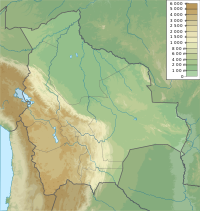카파 칸크리
Kappa Cancri| 관측 데이터 Epoch J2000.0 이쿼녹스 J2000.0(ICRS) | |
|---|---|
| 별자리 | 암 |
| 우측 상승 | 08h 20m 32.13630s[1] |
| 탈위임 | +24° 01′ 20.3198″[1] |
| 겉보기 크기 (V) | +5.233[2] |
| 특성. | |
| 스펙트럼형 | B8 IIIp[3] |
| B-V색지수 | −0.113[2] |
| 변수형 | α2 CVn[4] |
| 아스트로메트리 | |
| 고유 운동 (μ) | RA: −20.29[1]mas/yr Dec.: −18.81[1]mas/yr |
| 시차 (π) | 7.13 ± 0.38[1] 마스 |
| 거리 | 460 ± 20 리 (140 ± 7 pc) |
| 절대치수 (MV) | −0.82[5] |
| 궤도[6] | |
| 기간 (P) | 6.3933 d |
| 편심성 (e) | 0.13 |
| 페리아스트론 신기원을 이루다 (T) | 2440001.95 JD |
| 페리아스트론의 인수 (ω) (2차) | 157° |
| 반암도 (K1) (iii) | 67.4km/s |
| 세부사항[7] | |
| κ Cnc A | |
| 미사 | 4.5 M☉ |
| 반지름 | 5.0 R☉ |
| 루미도 | 322[5] L☉ |
| 표면 중력 (log g) | 3.7±0.1[2] cgs |
| 온도 | 12,800±200[2] K |
| 금속성 [Fe/H] | +0.51[5] 덱스 |
| 회전 속도 (v sin i) | 6±2km[2]/s |
| κ Cnc B | |
| 미사 | 2.1 M☉ |
| 반지름 | 2.4 R☉ |
| 표면 중력 (log g) | 4.0 cgs |
| 온도 | 8,500 K |
| 회전 속도 (v sin i) | 시속 40km |
| 기타 지정 | |
| 데이터베이스 참조 | |
| 심바드 | 자료 |
a 칸크리에서 라틴어로 표기된 카파 칸크리는 암의 십이지 별자리에 있는 청백색의 후두색 쌍성계다.그것은 육안으로 볼 때 +5.23의 겉보기 시야로 희미하게 보인다.[2]두 별의 크기 차이는 약 2.6이다.[9]지구에서 볼 수 있는 것과 같이 매년 7.13마스의 시차 변화를 바탕으로,[1] 이 시스템은 태양으로부터 약 460광년 떨어진 곳에 위치한다.
이것은 궤도 주기가 6.39일이고 이심률이 0.13일인 단일선 분광형 이항성계통이다[2].[6]1차 성분인 성분 A는 B8 IIIp의 별 분류를 가지고 있어 B형 거성임을 알 수 있다.[3]그것은 화학적으로 특이한 별의 한 종류로, 바깥 대기에서 이 두 원소의 큰 과장을 보여준다.[2]알파2 카눔 베나티오룸형 변광성(Alpha2 Canum Venaticorum type variable star)으로 분류되며, 밝기는 진도 +5.22에서 +5.27까지 5일의 기간으로 다양하다.[4]
1차 성분은 태양 질량의 4.5배, 태양 반지름의 5배, 유효 온도는 13,200K이다.2차 성분인 성분 B는 질량의 2.1배, 태양의 반지름의 2.4배의 작은 항성으로 유효온도는 8,500K이다.[7]
참조
- ^ a b c d e f van Leeuwen, F. (2007), "Validation of the new Hipparcos reduction", Astronomy and Astrophysics, 474 (2): 653–664, arXiv:0708.1752, Bibcode:2007A&A...474..653V, doi:10.1051/0004-6361:20078357, S2CID 18759600.
- ^ a b c d e f g h Maza, Natalia L.; et al. (December 2014), "A non-LTE spectral analysis of the 3He and 4He isotopes in the HgMn star κ Cancri", Astronomy & Astrophysics, 572: 7, arXiv:1412.2052, Bibcode:2014A&A...572A.112M, doi:10.1051/0004-6361/201425037, S2CID 119116996, A112.
- ^ a b Levato, H. (1975), "Rotational velocities and spectral types for a sample of binary systems", Astronomy and Astrophysics, 19: 91, Bibcode:1975A&AS...19...91L.
- ^ a b Samus', N. N.; et al. (January 2017), "General catalogue of variable stars: Version GCVS 5.1", Astronomy Reports, 61 (1): 80–88, Bibcode:2017ARep...61...80S, doi:10.1134/S1063772917010085, S2CID 125853869.
- ^ a b c Anderson, E.; Francis, Ch. (2012), "XHIP: An extended hipparcos compilation", Astronomy Letters, 38 (5): 331, arXiv:1108.4971, Bibcode:2012AstL...38..331A, doi:10.1134/S1063773712050015, S2CID 119257644.
- ^ a b Pourbaix, D.; et al. (2004), "SB9: The ninth catalogue of spectroscopic binary orbits", Astronomy & Astrophysics, 424 (2): 727–732, arXiv:astro-ph/0406573, Bibcode:2004A&A...424..727P, doi:10.1051/0004-6361:20041213, S2CID 119387088.
- ^ a b Ryabchikova, T. (April 1998), "Abundance analysis of SB2 binary stars with HgMn primaries", Contributions of the Astronomical Observatory Skalnate Pleso, 27 (3): 319–323, arXiv:astro-ph/9805063, Bibcode:1998CoSka..27..319R.
- ^ "kap Cnc". SIMBAD. Centre de données astronomiques de Strasbourg. Retrieved 2017-06-19.
- ^ Ryabchikova, T.; et al. (April 1998), "Discovery of the secondary star of the HgMn binary kappa CANCRI", Contributions of the Astronomical Observatory Skalnate Pleso, 27 (3): 258–260, arXiv:astro-ph/9805143, Bibcode:1998CoSka..27..258R.


